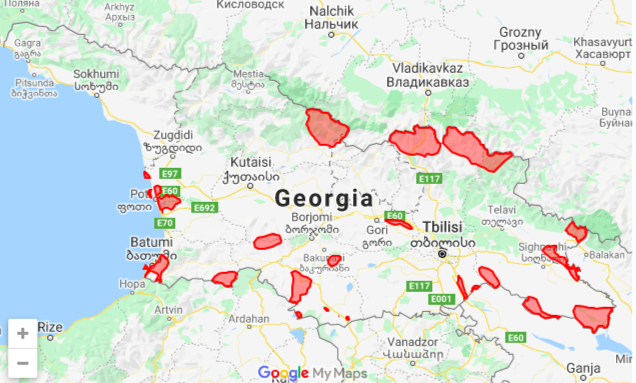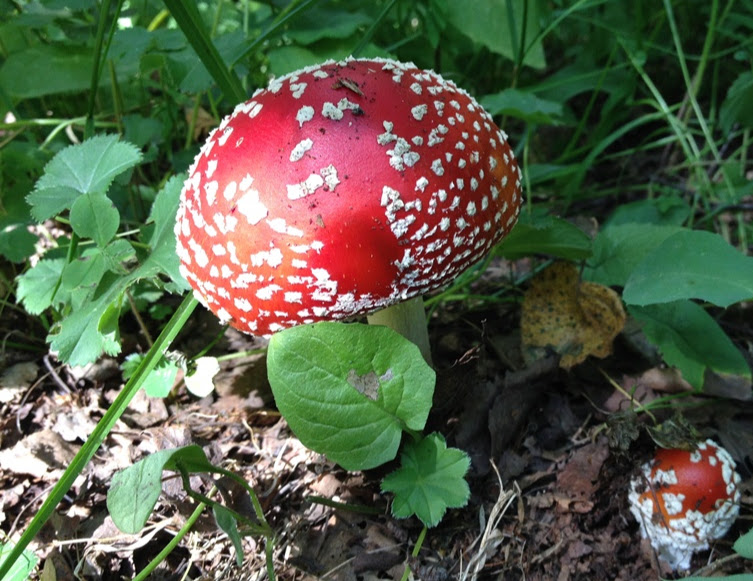Taxonomy
Kingdom Animalia (16266)Phylum Chordata (708)
Class Mammalia (111)
Order Artiodactila (12)
Family Suidae (1)
Genus Sus (1)
Species Sus scrofa
Browse by taxonomy
Simple search by name
Sus scrofa ✓
Wild Boar, გარეული ღორი
Name According To: https://www.iucnredlist.org/search?query=Sus%20%20scrofa&searchType=species
Species: scrofa
Taxon Rank: Species
Scientific Name Authorship: Linnaeus, 1758
Vernacular Name: Wild Boar
Georgian Name: გარეული ღორი
GBD Remarks:
Conservation Status (International): IUCN status - Least Concern. Widespread and common species with no major threats for the global population.
Conservation Status (national): Georgian Red List: not included, not evaluated.
Economic importance (national): game species, favorite for trophy hunters.
Methodological approaches: Monitoring should combine tracking on transects, direct visual counts from high watching points, counting at night using thermal imaging cameras as well as indirect methods (e.g. dung counting) (Krebs, 2006; Sutherland, 2006; Thompson et al., 1998). Observations on wild boar - visual observations and tracking (footprints, feces etc.) should be carried out by professional zoologists or trained experts together with with rangers and/or students. Counting all traces of the species within a protected area or sanctuary during multiple years will indicate the existing trend. For modelling population numbers, count data (from line or point transects), should be elaborated with software DISTANCE (Bukland et al. 2001, Thomas, L., et al. 2010) (http://www.ruwpa.st-and.ac.uk/distanc/).
Research activities: Contacts: Ilia State University, Institute of Ecology, Natia Kopaliani, Zura Gurielidze, Alexander Gavashelishvili. No ongoing research projetcs. Transect counts were hold in 2012, irregular counts are carried in the hunting farms, according to requests of Biodiversity Conservation Department of the Ministry of Environment Protection.
Specific relevant information: 2012 estimate (გურიელიძე, 2013) suggests size of national population between 1000-1500 individuals. Wild boars were few times introduced from distant geographic areas, and extensive hybridization with wild pigs most likely takes place. Presumably population size appears to dropped sharply in late 2000s as a result of the African Plague epidemy.
Relevant website: http://www.iucnredlist.org/details/41775/0
Why to monitor: In protected areas, information on the wild boar number should be published regularly, which is unfortunately not the case. Other reasons include necessity of the counts in managed sanctuaries and epidemiological reason (rick of transferring deceases between domestic pig and wild boar).
Preliminary suggestion: Conduct baseline genetic study to identify the degree of interbreeding between autochtonous and allochtonous boars, and between domestic pig and wild boar. Estimate effective population size using population genetic methods. Require at least biannual census results from the protected areas and private hunting farms.
კონსერვაციული სტატუსი (საერთაშორისო): IUCN სტატუსი - LC. ფართოდ გავრცელებული მრავალრიცხოვანი გლობალური პოპულაცია.
კონსერვაციული სტატუსი (ეროვნული): არაა შეფასებული.
ეკონომიკური მნიშვნელობა (ეროვნული): სატროფეო და სხვა სახის ნადირობის მნიშვნელოვანი ობიექტი.
მონიტორინგის მეთოდები: მონიტორინგი უნდა ეყრდნობოდეს ტრანსექტებზე აღრიცხვის, პირდაპირი თვლის ამაღლებული წერტილებიდან, ღამის თვლებს თერმალური კამერების მეშვეობით და არაპირდაპირი მეთოდების (მაგ. კვალის ან ნაკელის თვლის) კომბინაციას (Krebs, 2006; Sutherland, 2006; Thompson et al., 1998). დაკვირვებები და კვალზე დადევნება უნდა განახორციელონ პროფესიონალ ზოოლოგებმა და რეინჯერებმა/სტუდენტებმა. მრავალწლიანი დაკვირვების საფუძველზე გამოსავლენია პოპულაციის ტრენდი. პოპულაციის რიცხოვნობის მოდელირებისთვის გამოსადეგია პროგრამა DISTANCE (Bukland et al. 2001, Thomas, L., et al. 2010) (http://www.ruwpa.st-and.ac.uk/distanc/).
მიმდინარე კვლევები: კონტაქტები - ილიას სახ. უნივერსიტეტი, ეკოლოგიის ინსტიტუტი, ნათია კოპალიანი, ზურა გურიელიძე, ალექსანდრე გავაშელიშვილი. ამჟამად აღრიცხვები არ მიმდინარეობს. 2012 წელს ჩატარდა ტრანსექტებზე აღრიცხვები (გურიელიძე 2013), ტარდება არარეგულარული აღრიცხვები სანადირო მეურნეობებში გარემოს დაცვის სამინისტროს მოთხოვნით.
სპეციფიკური ინფორმაცია: 2012 შეფასებით (გურიელიძე, 2013) ეროვნული პოპულაციის რიცხოვნობა 1000-1500 ინდივიდს ითვლის. ტახები რამოდენიმეჯერ შემოიყვანეს საქართველოში დაშორებული რეგიონებიდან, და სავარაუდოდ დღეს საქართველოში მობინადრე ტახები შერეულია როგორც ამ შემოყვანილ ღორებთან, ასევე შინაურ ღორებთან. სავარაუდოდ 2000-ანი წლების ბოლოს პოპულაცია მნიშვნელოვნად დაეცა აფრიკული ჭირის ეპიდემიის შედეგად.
რელევანტური ვებსაიტი: http://www.iucnredlist.org/details/41775/0
რატომაა საჭირო მონიტორინგი: დაცული ტერიტორიების მოვალეობაშია რეგულარული აღრიცხვების შედეგები წარუდგინონ სამინისტროს, თუმცა ასეთი ინფორმაცია მიუწვდომელია. მონიტორინგის საჭიროების სხვა არგუმენტებია სანადირო მეურნეობების არსებობა და ეპიდემიოლოგიური უსაფრთხოების აუცილებლობა.
რეკომენდაცია: ჩატარდეს საბაზო გენეტიკური კვლევა იმისთვის, რომ დადგინდეს ავტოქტონური და ალოქტონური ღორების, ასევე გარეული და შინაური ღორების ჰიბრიდიზაციის დონე. პოპულაციურ-გენეტიკური მეთოდებით დადგინდეს პოპულაციის ეფექტური რიცხოვნობა. ერთ-ორ წელიწადში ერთხელ გარემოს დაცვის სამინისტრომ მოსთხოვოს დაცული ტერიტორიების ადმინისტრაცებს და სანადირო მეურნეობის მფლობელებს ტახის აღრიცვის შედეგები.
Page Authors: Kandaurov A. , David Tarkhnishvili
Reference of occurrence in Georgia: Bukhnikashvili, A. & Kandaurov, A., 2002. The annotated list of mammals of Georgia. Proceedings of the Institute of Zoology, Tbilisi, XXI: 319-336
Information from GBIF about Sus scrofa
GBIF scientific name: Sus scrofa Linnaeus, 1758
GBIF taxonomic status: ACCEPTED

Conservation Status
This section is under construction
National Red List Status: DD
IUCN Red List Status: LC
Protection status: Not defined
Reason: N/A
Trend: Unknown
EOO: 42 000
AOO: 19 800
Native/Introduced: Native
Comment: DD (მონაცემების ნაკლებობა). გარეული ღორის პოპულაცია დატოვებული ნიშნების მიხდვით ბოლოს 2012 წელს შეფასდა (სამონადირეო მეურნეობების გარეთ). რიცხოვნობა დაახლოებით 1500 ინდივიდს შეადგენდა. თუმცა, მას მერე, ზოგ ტერიტორიებზე აღინიშნა ღორების მასობრივი სიკვდილიანობა. მაგალითად, ილტოს ხეობაში, დუშეთის რაიონში (ადგილობრივი მოსახლეობის მიერ მოწოდებული ინფორმაცია). სავარაუდოდ, დაავადებების გამო. გარეული ღორის პოპულაციაზე მოქმედებს ჰიბრიდიზაცია შინაურ ღორთან, რაც ზრდის დაავადებების გავრცელების რისკს და მოქმედებს გარეული ღორის პოპუულაციის ადაპტურ პოტენციალზე. ყოველივე ზემოთქმულიდან გამომდინარე, საჭიროა გარეული ღორის პოპულაციის რიცხოვნობის შეფასება საქართველოს ტერიტორიაზე თანამედროვე მეთოდების გამოყენებით.
Georgian Name: გარეული ღორი
English Name: Wild Boar
Taxonomy according to: https://www.iucnredlist.org/search?query=Sus%20%20scrofa&searchType=species
References: **
Evaluated By: Kopaliani N, Gurielidze Z
Date evaluated: Nov 2021


